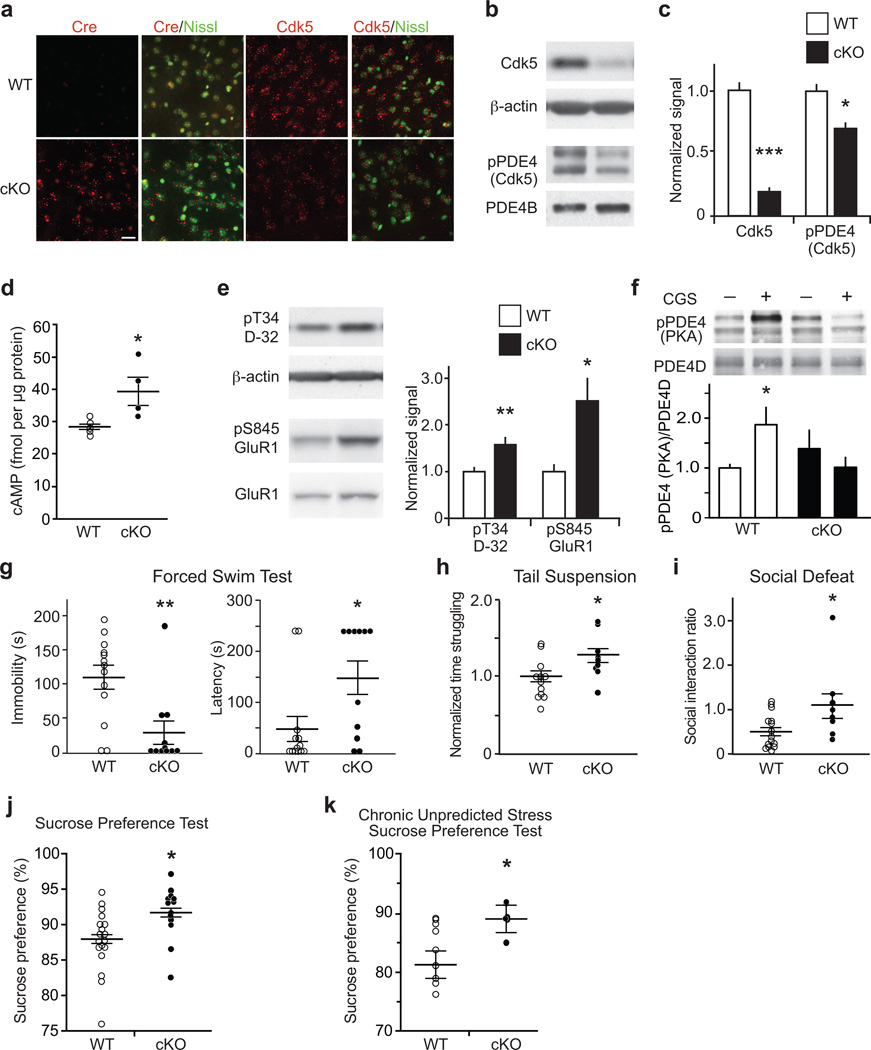Figure 2.
Cdk5 cKO mice exhibit elevated cAMP, increased PKA activity, and altered behavioral responses in paradigms of acute and chronic stress. (a) Fluorescence in situ hybridizations for Cdk5 and Cre in striatum of WT versus Cdk5 cKO mice with Nissl counterstain. Scale bar = 20 µm. (b,c) Reduced Cdk5 expression and Cdk5-dependent PDE4 phosphorylation in Cdk5 cKO striatum (Cdk5: n = 4 mice; ***P < 0.0001; pPDE4 (Cdk5): WT n = 4; cKO n = 5; *P = 0.042). (d) Increased cAMP in Cdk5 cKO (WT n = 5; cKO n = 4; *P = 0.0286;). (e) Elevated PKA-dependent phosphorylation of Thr34 DARPP-32 (pT34 D-32) and Ser845 GluR1 (pS845 GluR1) in Cdk5 cKO (WT n = 7; cKO n = 9; pT34 D-32: **P = 0.0084; pS845 Glur1: *P = 0.024). (f) Loss of PKA-mediated PDE4 phosphorylation in response to the adenosine A2A receptor agonist CGS21680 (CGS; 5 µM; 2 min) in Cdk5 cKO striatum (n = 4 slices from 2 mice; WT CGS vs cKO CGS: *P = 0.0354). (g–k) Cdk5 cKO mice exhibit altered stress-induced behavior, in the FST with reduced immobility time and increased latency to initiation of floating (WT n = 13; cKO n = 11; Immobility: **P = 0.0035; Latency: **P = 0.0201) (g), in the TST with increased time struggling (WT n = 12; cKO n = 9; *P = 0.0281) (h), in SD with elevated social interaction ratio as the Cdk5 cKO showed reduced avoidance (WT n = 15; cKO n = 8; *P = 0.0309) (i), in the SPT, a measure of anhedonia, with increased sucrose preference (WT n = 19; cKO n = 13; *P = 0.0156) (j), that persisted after exposure to chronic unpredicted stress (WT n = 10; cKO n = 6; *P = 0.0497) (k). Whole immunoblot images are presented in Supplementary Fig. 13. All data shown are means ± s.e.m., *P < 0.05, **P < 0.01, ***P < 0.001.

